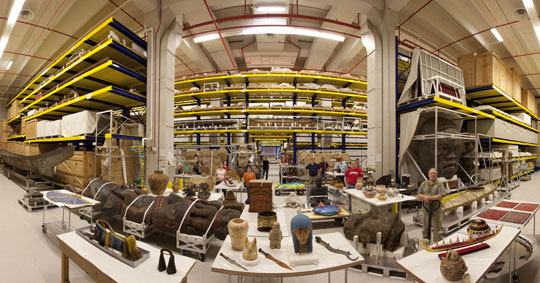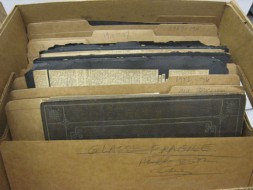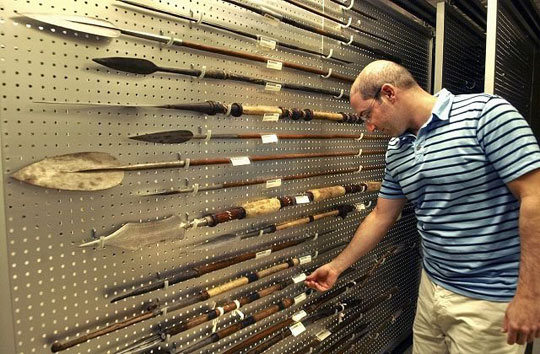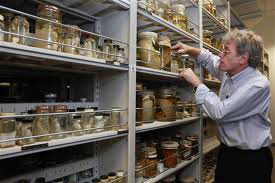From the Secretary: A collective endeavor
Smithsonian collections total 137 million objects and specimens, 1.9 million library volumes, and more than 120,000 cubic feet of archival material. These resources can be accessed by millions of visitors and researchers worldwide delving into subjects from aeronautics to zoology, either in person or increasingly, online. Thanks to our talented and dedicated curators and conservators, the scope and depth of the Smithsonian’s collections is unmatched by any other institution in the world, revealing an astonishing record of American and international artistic, historical, cultural and scientific achievement. Our collections are comprised of objects found in tropical rainforests and arid archaeological sites, the depths of the oceans and the vast expanse of space, and even in people’s basements and backyards. But no matter their origins, our collections are painstakingly preserved and maintained so these artifacts and specimens can be studied and enjoyed for generations to come.

A panoramic view of Pod 4 at the Museum Support Center with the Collections Support Staff responsible for the move of objects. In the foreground at right is one of the Smithsonian’s two Easter Island stone figures. (Photo by Chip Clark)
Stewardship
Collections stewardship is one of the Smithsonian’s highest priorities and in some cases, its greatest challenge. The volume, characteristics, diversity and age of Smithsonian collections, and the variety of discipline-specific standards that determine their care, mean that the complexity of managing the collections rivals that of the collections themselves. The condition of the facilities that house our collections, the quality of storage and preservation, and the ability to document in manual and digital formats directly affect the Smithsonian’s capacity to make our collections available to scholars and the public.

The Archives of American Art received a grant to stabilize and rehouse 13 fragile collections such as this on e in 2010.
With targeted funding, the Smithsonian has made significant strides in improving the management, care and accessibility of collections through assessments, long-term planning and prioritization. We consider many factors when deciding on a course of action, including our mission and strategic plan; which collections are most at risk and need immediate preservation; and which have the greatest potential for research, exhibition and education. By taking a holistic approach to collections management, we have capitalized on economies of scale and improved care in a way that benefits the greatest number of collection items most efficiently, practically and cost-effectively.
Finding solutions
Several important strategic initiatives are currently underway which will greatly improve collections care and accessibility, including:
- Creation of the Deputy Under Secretary for Collections and Interdisciplinary Support position and office to improve visibility, supervision and coordination of collections-related activities.
- Implementation of an Institution-wide collections assessment program which will guide the long-term care of collections, identify areas for improvement, establish priorities, measure progress and provide a practical framework to allocate collections resources.
- Establishment of a central office to execute our digitization strategic plan. This office will guide digitization of collections and research holdings, issue central policy guidance, develop plans for unit digitization and asset management, and document the progress of this strategic plan.
- Implementation of an Institution-wide collections space planning initiative to survey the current condition of Smithsonian collections space and develop a master plan to address current and future needs to properly house our growing collections.

Support Center. The facility contains more than half a million square feet of secure storage space for the items that are not on display. (Photo by Bert V. Goulait/The Washington Times)
Recent Facility Capital Projects have also provided safer environments for millions of collections items. These include the renovation of Pod 3 and construction of Pod 5 at the Suitland Museum Support Center, the lease and development of the Pennsy Drive Collections and Support Center in Maryland; the construction of Hazy I and II in Chantilly, Va.,and the relocation of some collections to Capital Gallery and to an off-site facility in New Jersey. A number of other revitalization efforts have also taken place throughout the National Mall buildings and at the Zoo.
Funding solutions

Smithsonian Institution Libraries surveyed the conservation and preservation needs of the materials in the Cooper-Hewitt, National Design Library. This Costume Color Council serial provides patterns, colors and material that were in vogue in 1950 and includes garment fabric swatches, nylon stocking samples and dress illustrations. It is held in only one other public institution worldwide but fragile paper and loose binding prohibit handling for either exhibition or research.
A diversified funding strategy for these capital and collections improvements will continue to be a priority. From fiscal year 2006 to 2012, requests to the Office of Management and Budget have incorporated increases for collections care totaling $39.7 million, including staff. Since fiscal year 2006, the Smithsonian’s annual Federal appropriation has included an Institution-wide funding program to address critical needs in collections care and preservation, and we have also invested more than $300 million in new and upgraded facilities to house our collections. The Collections Care and Preservation Fund provides funding in support of projects that address the Smithsonian’s strategic priority to strengthen collections. From fiscal years 2006 through 2011, $10.2 million has been allocated to 114 CCPF projects across the Smithsonian enabling significant collections management improvements, such as:
- Addressing the Smithsonian’s Inspector General audit recommendations regarding deficiencies in collections management.
- Stabilizing, re-housing and conserving millions of items for long-term preservation and accessibility.
- Purchasing space-efficient storage units and replacing substandard cabinetry.
- Conducting comprehensive assessments to establish priorities and action plans for the allocation of collections care resources.
The Smithsonian has also successfully obtained private funding and grants for collections care and digitization.
The future of our collections

Jonathan Coddington, Associate Director for Research and Collections at the National Museum of Natural History, among the collections at the Museum Support Center.
From the inception of the Smithsonian Institution, collections have formed our bedrock foundation. In 1838, Charles Wilkes led the U.S. Exploring Expedition on an ambitious four-year voyage of discovery. By its completion in 1842, it had amassed an impressive array of anthropological artifacts and biological and geological specimens. It would be another 16 years before those collections were added to the Smithsonian’s holdings, which had grown considerably in that time. Those meticulously researched and catalogued objects helped establish the Smithsonian as the country’s first national museum. Then, as now, it was a challenge to store, display and preserve these collections.
The Smithsonian will continue to prioritize and systematically address critical collections care needs based on collections assessments, current best practices, project-driven activities and economies of scale. We will also continue to secure public and private funding and seek out new partnerships so that our unparalleled collections will remain an invaluable resource for visitors, students and researchers all over the world.
Posted: 5 December 2011
- Categories:



